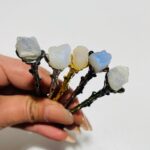Amethyst, a captivating gemstone known for its enchanting purple hues, has captivated jewelry enthusiasts and collectors alike for centuries. With its alluring beauty and diverse applications, it’s no surprise that amethyst prices vary depending on various factors. This comprehensive guide will delve into the world of amethyst pricing, helping you understand the determinants and make informed decisions when purchasing this magnificent gem.

Factors Influencing Amethyst Prices
The value of amethyst is influenced by a plethora of factors, each contributing to its overall worth. Understanding these parameters is crucial for both buyers and sellers.
1. Color: Hue, Saturation, and Tone
Color is paramount in determining amethyst prices. The most desirable amethysts exhibit a deep, rich purple color known as “Siberian Amethyst” or “Royal Amethyst.” Higher saturation and darker tones command a premium.
2. Carat Weight
Carat weight refers to the mass of an amethyst, measured in carats (1 carat = 0.2 grams). Larger amethysts, particularly those weighing several carats, are more valuable due to their rarity.
3. Clarity
Clarity relates to the presence of inclusions or blemishes within the amethyst. Eye-clean amethysts, free from noticeable inclusions, are more highly prized and expensive.
4. Cut
The cut of an amethyst affects its brilliance and durability. Well-cut amethysts maximize light reflection, enhancing their visual appeal. Popular cuts include oval, cushion, and trillion.
5. Origin
The origin of an amethyst can also influence its price. Amethysts from certain regions, such as Brazil, Zambia, and Madagascar, are known for their exceptional quality and command higher prices.
6. Treatment
Some amethysts undergo treatments, such as heat treatment, to enhance their color or remove impurities. While treated amethysts are generally less expensive than untreated stones, they may still be valuable if the treatment is skillfully executed.
Pricing Range of Amethysts
The price of amethysts can vary significantly depending on the aforementioned factors. Here’s an approximate range of prices for different grades and sizes:
| Grade | Price per Carat |
| Low (pale color, visible inclusions) | $5-$15 |
| Medium (good color, medium inclusions) | $15-$40 |
| High (deep color, eye-clean) | $40-$100 |
| Exceptional (Siberian Amethyst, flawless) | $100-$500 |
Step-by-Step Guide to Purchasing Amethysts
To ensure you acquire an amethyst that meets your desires and budget, follow these steps:
1. Determine Your Budget
Establish a budget that you’re comfortable spending, keeping in mind that amethyst prices vary based on quality and size.
2. Research and Compare Prices
Shop around at reputable jewelers and online retailers to compare prices and find the best deals. Check customer reviews and verify the reliability of the seller.
3. Consider the 4Cs
Assess the amethyst’s color, carat weight, clarity, and cut to determine its value. Prioritize the factors that are most important to you.
4. Evaluate the Certification
Look for amethysts accompanied by a certificate from a reputable gemological laboratory, such as the Gemological Institute of America (GIA). This will provide assurance of the stone’s quality and authenticity.
5. Make an Informed Decision
After considering all the factors, make an informed decision that aligns with your budget and preferences. Remember, the most valuable amethyst is the one that brings you joy and fits your personal style.
Applications of Amethysts: Beyond Jewelry
Amethysts are not just limited to jewelry. Their allure and properties have led to various applications in different fields:
1. Metaphysical Properties
Amethyst is believed to possess metaphysical properties associated with spiritual growth, tranquility, and emotional balance. Many use it in meditation and healing practices.
2. Decorative Objects
Larger amethysts are often fashioned into decorative objects, such as sculptures, vases, and home décor. Their rich color and captivating presence add a touch of elegance to any space.
3. Energy Healing
Some healers incorporate amethysts in energy healing sessions. The crystal’s calming vibrations are said to promote relaxation and reduce stress.
4. Technical Applications
Amethysts have a unique piezoelectric effect, which makes them useful in certain technical applications, such as pressure sensors and oscillators.
Table 1: Amethyst Prices by Color Grade
| Color Grade | Price Range per Carat |
| Fancy Deep Purple | $100-$250 |
| Fancy Purple | $75-$150 |
| Deep Purple | $50-$100 |
| Medium Purple | $25-$50 |
| Light Purple | $10-$25 |
Table 2: Amethyst Prices by Carat Weight
| Carat Weight | Price Range per Carat |
| 0.5 Carat | $20-$50 |
| 1 Carat | $40-$100 |
| 2 Carats | $80-$200 |
| 3 Carats | $120-$300 |
| 5 Carats | $200-$500 |
Table 3: Amethyst Prices by Clarity Grade
| Clarity Grade | Price Range per Carat |
| Eye-Clean | $50-$150 |
| Slightly Included | $25-$75 |
| Included | $10-$30 |
| Heavily Included | $5-$15 |
Table 4: Amethyst Prices by Cut
| Cut | Price Range per Carat |
| Oval | $30-$80 |
| Round | $25-$70 |
| Emerald | $20-$60 |
| Cushion | $25-$75 |
Conclusion
Amethyst prices are multifaceted, influenced by a combination of factors that interact to determine the value of each unique stone. By understanding these determinants, buyers can make educated decisions and acquire amethysts that align with their preferences and budget. Whether it’s a stunning piece of jewelry, a decorative object, or a tool for personal growth, amethysts offer a kaleidoscope of possibilities. With their timeless beauty and versatile applications, the captivating power of amethysts will continue to enchant and inspire for generations to come.




























